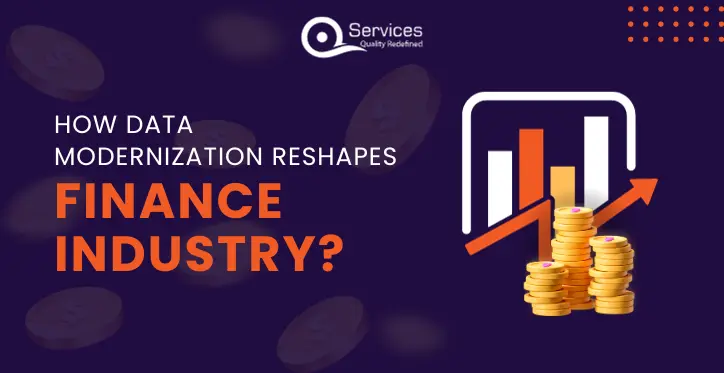Home » How Data Modernization Reshapes Finance Industry

In this digital world, almost every industry is changing with the advancement of technology, and it’s not leaving the finance industry behind. Even though it is giving finance a digital makeover, people crave convenience and accessibility, and today they want the same for their banking experiences as they get them online, and data modernization is helping the financial institutions to do so. So, in this blog, we will discuss data modernization in the finance industry.
Do we all understand what data is, right? It consists of several things like information and figures. Modernizing this data is a big improvement because organizations use it for everything from consumer information to financial transactions. Or, to put it another way, data modernization is just an enhancement of the way we handle and manage data with the newest technologies and modern methods in order to boost efficiency and security. In technical term, data modernization is the process of moving fragmented data from outdated cloud-based databases to modern ones. Through data modernization, organizations can grow more agile and eliminate unnecessary complexity and inefficiencies.
The financial industry is not as simple as we once thought. It is a multi-layer structure. The necessity for modernization is becoming more and more evident as the banking industry changes into a multi-layered structure due to the rise of mobile banking. With the ease of mobile banking at their fingertips, customers now expect a smooth, intuitive experience that cuts across the conventional boundaries seen in financial institutions.
These institutions’ multi-layered complexity makes it difficult to satisfy the changing expectations of their customers. In this case, modernization is a great approach to match the operational layers.
With the help of data modernization, finance institutions can optimize their data management processes, enhance operational efficiency, and, most crucially, cater to the dynamic expectations of customers engaging with banking services through mobile platforms.
Get free Consultation and let us know your project idea to turn into an amazing digital product.
The Challenges highlighted below is related to the data issues faced by financial organizations are like delayed access to data, difficulty in sourcing data from various channels, and the struggle to obtain data in the required format. Let’s discover how data modernization can address these challenges:
Data modernization involves transitioning from legacy systems to more agile and responsive infrastructures, allowing financial institutions to access data in real time. Implementation of technologies like data lakes and cloud-based solutions facilitates faster data retrieval, eliminating delays and enabling timely decision-making.
Consolidation and integration of various sources of data into a single platform is the focus of data modernization. Institutions can eliminate data silos and guarantee smooth access to information from different departments and locations by implementing modern data management procedures.
Modern data architectures, such as data fabrics, provide the flexibility to handle data in multiple formats. The ability to adapt to diverse data formats ensures that financial institutions can obtain information in the required structure, aligning with their analytical and decision-making needs.
Data modernization initiatives often involve breaking down silos, creating a cohesive data environment where information can flow freely. The integration of data and applications across the organization enhances collaboration and provides a comprehensive view, eliminating siloed barriers.
Recognizing the importance of real-time data, financial institutions can prioritize data modernization initiatives to enable swift access to critical information. Technology like advanced analytics contribute to the delivery of real-time insights for informed decision-making.
Data modernization creates an open data environment that makes it possible to collaborate with fintechs. Financial institutions can easily link with outside partners through updated data infrastructure, which promotes innovation and maintains competitiveness.
According to a Forrester report, 73% of data and analytics professionals globally utilize data and analytics to develop or improve automation operations. There are several positive impacts of data modernization on the finance sector which includes:
Financial institutions are able to act more quickly and intelligently in the moment when they have instant access to data. With data modernization, they can effectively give access for data democratization. By using data to take action and improve business processes, organizations can lower the risk of costly errors and increase overall performance.
Financial companies that integrate diverse data sources and use automated data modernization to execute real-time processing can enhance information access and operational efficiency. The automation of routine tasks with agile data management frameworks reduces manual interventions. Advanced storage solutions, such as cloud-based databases, optimize data retrieval, promoting quicker and more efficient operations.
With the help of data modernization stakeholders can easily access data from anywhere. Through data modernization, you can boost visibility into sensitive data and restrict access while keeping individuals able to perform their jobs.
Data modernization in the financial industry refers to modernizing and effectively optimizing data infrastructure. Financial institutions can lower associated costs and enhance regulatory compliance by automating repetitive processes, optimizing operations, and enhancing data quality through the use of data analytics and modern technology.
Modernizing the architecture framework in the financial sector is essential to enhancing data security since it allows for the use of modern encryption techniques, access control, and monitoring capabilities. This helps to safeguard sensitive data and reduces the possibility of data breaches and cyberattacks.
In today’s tech-driven environment, accessibility and usability are priorities for every consumer. Data modernization in the financial sector enhances the customer experience by using customization and adjusting data modernization services to specific client preferences.
The first and most important stage of every successful data modernization initiative is strategic planning. Financial intuitions need to know their goals, which require creative planning that takes the future and the present into account. They have to maintain a detailed plan that includes their goals, timetable, budget, and inventory of resources.
The second most crucial step is utilization of technology and for that you need to choose the right technology and tools that can easily support your data modernization project. Organizations need to consider introducing new technologies and transferring their data to the cloud to modernize their data architecture. While cloud platforms provide a cost-effective and scalable option for data management and storage, newer technologies like machine learning and artificial intelligence can improve decision-making by providing new insights. Verify that the technology you have selected will support your aim and grow as needed.
The potential of digital transformation can be fully realized by modernizing your data integration processes. These days, having data from different sources, volumes, and types is not difficult. Modern integration solutions enable your team to have data in a single, unified environment and gain critical insights.
It is advised that organizations focus on major modernization projects, such as introducing new ingestion techniques, looking into new platform types, and facilitating self-service access. Additionally, improving your integration technology can help you maintain your competitiveness in the market.
To safeguard sensitive data, strong security measures must be taken. Maintain competitiveness by complying to appropriate information privacy standards.
By the integration of Artificial intelligence and machine learning in data modernization brings advanced data analytics like automation which helps the financial institution to predict the future and elevate their decision-making process by data-driven insights.
All the businesses are shifting to cloud because of its advanced analytical and storage capabilities so financial sector should also migrate to cloud for efficient decision making in context of data modernization.
Data lakes and warehouses serve as a comprehensive data warehouse management dsystem to store vast amount of data which enhances the accessibility and helps organizations to efficiently organize, retrieve and analyse data for meaningful data insights.
Blockchain Technology introduces a secure and transparent ledger system which is a significant part of the financial sector. It helps in integrity of the payment transactions by creating a record and reduces the risk of fraud.
Data governance, which serves as a process of controlling the availability, accessibility, and security of data in enterprise systems, is a crucial component of the data modernization strategy since it guarantees that organizations to use data in a secured way.
Data modernization in finance sector plays a crucial role in transforming collected data into insightful knowledge. The process involves employing contemporary data modernization strategies and tools to overcome data silos and provide results.

Content writer
INDIA : F-190, Phase 8B, Industrial Area, Sector 74,
Mohali, India
CANADA : 55 Village Center Place, Suite 307 Bldg 4287, Mississauga ON L4Z 1V9, Canada
USA :2598 E Sunrise Blvd, Fort Lauderdale,FL 33304,
United States

Founder and CEO

Chief Sales Officer
